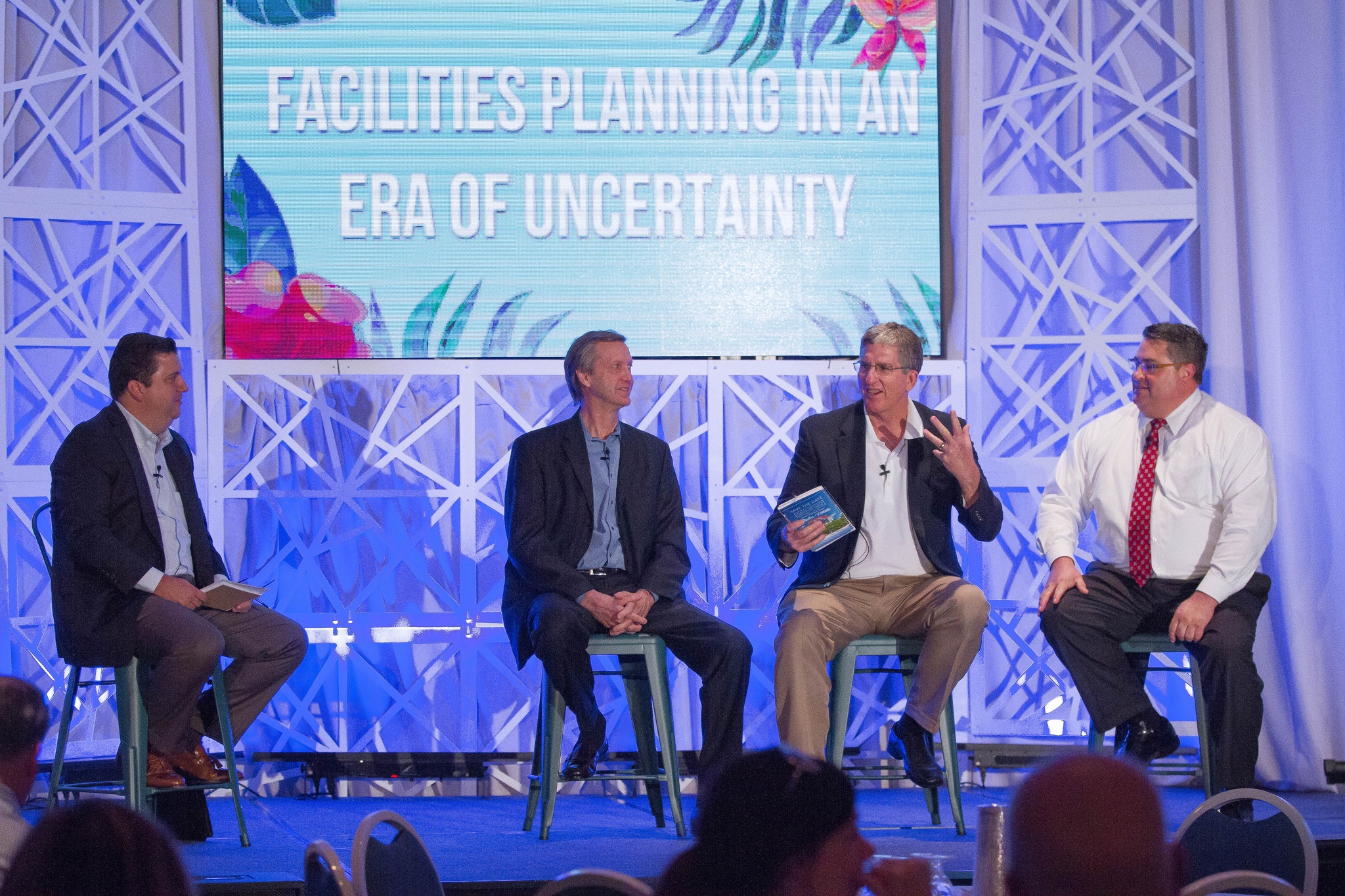In the healthcare industry, where it’s not always clear what lies ahead, how can we remain strategic and actually provide our organizations a point of certainty?
At the Health Facilities Innovation Forum (now HealthSpaces), Rustin Becker, Executive Vice President at Erdman, led a conversation focused on how health systems across the country are optimizing the performance of their portfolios and focusing on the variables they can control. Participants included...
- David Glasscock, VP, Real Estate at Catholic Health Initiatives
- Dave Kistel, VP, Facilities & Support Services at Lee Health
- Derek Watson, Sr. Director of Planning, Design & Construction at Children’s Health
Planning for a Hazy Future
Becker kicked off the discussion by asking participants about the evolution of their planning process: how are they tackling long-term planning and assessing their needs?

Dave Kistel shared the 10-year future-focused master plan Lee Health developed just a few years back. To combat tunnel-vision, a team was composed of representatives from a variety of sectors, including post-acute care staff, general pediatric physicians, and primary care doctors.
“It’s all about getting the right people at the table and integrating thoughts before you start drawing.”
-Dave Kistel, VP, Facilities & Support Services at Lee Health
Together, the team looked at how they could make integrated care work in the communities they served. This focus was crucial, as the organization was struggling to deal with surges in demand created by seasonal residents and a large elderly population. The outcome of thinking of the process as a whole was “revolutionary” with massive improvements.
One of the results was the planning of a bedless hospital in Naples after the community had expressed a need for a facility that wasn’t “for sick people”, but instead, a place of health. Opening in fall 2018, the new facility will include a healthy lifestyle center that helps patients learn how to care for themselves and manage their health, thus lowering the need for more serious hospital services.
Overall, Lee Health is paying greater attention to how it can attune itself to its patient demographics. Because of their large number of elderly patients, their facilities must provide more accommodations than average. Some of these accommodations include an increase in ICU beds and expanded dialysis services.
Derek Watson also shared some of the planning strategies at Children’s Health, which includes relying on data and analysis to see which upgrades will have the most impact and provide the highest ROI.
One example is the renovation of their perioperative spaces. Before any design work is done, they’re tracking workflow and traffic in these sections by installing RFID trackers in the badges of all personnel. Streamlining their designs based on these findings will enable staff to treat more patients and improve the hospital’s revenue.
Preparing for What’s Beyond Our Control
Next up in the discussion was public health policy. Namely, how are facilities execs coping with their susceptibility to its changes?
“If you look at Medicare and Medicaid, we’re pretty much federal government paid. So anytime there is an impact on Medicare and Medicaid (usually it’s taking money away), it sends shivers through our organization,” said Kistel.
Kistel’s team is focused on shifting to outpatient care and finding more revenue. One of their biggest current challenges is replacing physicians who are at retirement age: they’re pushing hard on recruitment, but young physicians aren’t interested in the traditional model of working all hours for 20 years to earn residency. This is forcing Lee Health to come up with a new model that will attract the next generation of doctors.

Watson’s answer was concentrated on public education: Children’s Health is partnering with Dallas Independent School District, putting nurses and virtual health machines in almost every school. Educating communities so that they can live healthier lifestyles will cut down on service needs for preventable illnesses, such as diabetes.
David Glasscock pointed out that trims are sometimes necessary:“You can’t do everything.” CHI is getting back to its core business by cutting alliances in non-profitable business domains, such as research.
Adapting to New Approaches
Becker followed up on Watson’s mention of population health, asking the panelists about their general strategies for adapting to this new shift in the dynamics of healthcare.
“I think we all believe that, in the future, hospitals are going to be a cost center and people coming into the hospital are going to be a cost to us. I’m not sure exactly when that’s going to unfold, but there will be larger incentives to keep people out of the hospital,” said Kistel.
Running analytics on the sickest and most frequent patients is a top priority for Lee Health. They’re putting teams together to figure out how they can prevent continuous hospital admissions for their chronically ill patients. This is important for their revenue, as Medicare patients who are readmitted for the same DRGs within 30 days are “free patients”, and the hospitals get penalties from Medicare.
The current focus is on managing health from home, sending nurses to the patient homes and providing telehealth services. Kistel says it’s a cost now, but his team is seeing it as an investment that will pay off in the future.
In Texas, Children’s Health is using tech to monitor medications. One example is installing tabs that send signals to the hospital every time a patient uses their inhaler. Watson says they’re looking into digital, at-home monitoring devices that patients can check into every morning to log their heart rate, blood pressure, weight, etc.
Smarter Space Management
The final topic of conversation addressed underutilized spaces.
In Colorado, Glassock points out that certain facilities in rural areas just aren’t getting used. CHI is focused on determining how to convert these spaces to accommodate more revenue-generating services, such as clinic care. If CHI has leased space that they aren’t going to be able to maximize, they currently try to work out an early exit from the contracts. Now, when they set up new contracts, they ask for shorter lease terms to gain the flexibility to make adjustments.
Kistel shared that Lee Health is putting all its concentration on direct care, as devoting space to these services is the best use of its dollars. This means moving teams that weren’t providing direct care out of the hospitals.
He warns that facilities leaders have to be careful because some decisions can come at a cost. During the last hurricane, Lee Health’s storm team needed to evacuate their families to the hospital, but the reutilization made it so there weren’t any soft spaces that could accommodate the families. Leaders have to make sure that their attempts at optimization don’t undercut their abilities in critical moments.
For more on how facilities execs can remain strategic amid an era of uncertainty, join us at the 2018 Health Facilities Innovation Forum, taking place October 28-30 in Naples, FL.

Posted by
Collaborate with your Peers!
HealthSpaces is a community for people that plan, design, build and operate spaces where healthcare is delivered.
June 7-9, 2026 | Braselton, GA
Learn More




-4.png)
-Dec-09-2025-05-48-44-4379-PM.png)
-4.png)
-1.png)
-2.png)

Comments